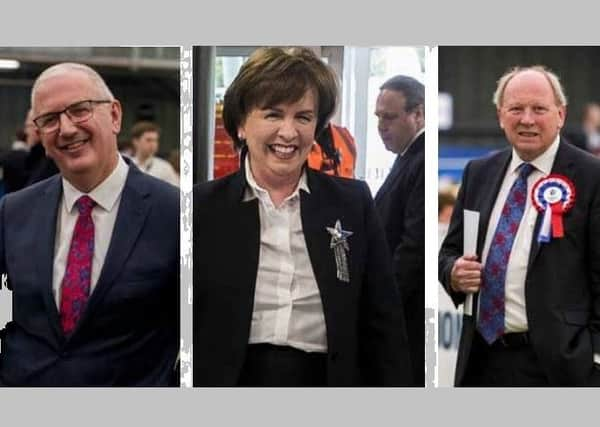Ben Lowry: The Northern Ireland MEP election results were bad, almost disastrous, for the unionist parties


It didn’t — it had a bad one.
Do not think either that the DUP had a good result, just because Diane Dodds came within a whisker, 1,960 votes, of Martina Anderson, making up most of the 28,700 shortfall in 2014.
It didn’t, it too had a bad one.
Unionism as a whole had a bad, almost disastrous, result yesterday, collecting a feeble 42.9% of overall votes cast, one of the lowest shares it has ever received in a Northern Ireland-wide election (the council election of three weeks ago is almost the only time that percentage was even lower).
Advertisement
Hide AdAdvertisement
Hide AdIndeed the sole consolation for unionists to be taken from yesterday’s overall MEP vote tallies is that it was an even worse result for nationalists.
Total first preference vote share is as important as the identity of the candidates who are elected to Strasbourg, or perhaps more so, because it reveals Northern Ireland voters’ primary political allegiance. Total MEP votes by community alignment were:
Unionist 245,841 42.9%
Nationalist 205,540 35.9%
Other 121,066 21.1%
Total 572,447
The unionist total share of the vote was poor, the nationalist share in yesterday’s results was a mere 35.9% — dreadful by recent nationalist standards. If it was not for that low total, nationalists could claim that there was enough evidence of support for Irish unity to justify a border poll.
Anecdotal evidence from the Alliance Party on the doorsteps that it was picking up a notable proportion of the nationalist votes is borne out by the hard data of the actual results. It is also clear that Alliance has siphoned off a significant minority of unionist votes.
Advertisement
Hide AdAdvertisement
Hide AdThe overall non aligned (neither unionist nor nationalist) vote at 21.1% is wholly without electoral precedent in NI, since the onset of the Troubles.
Alliance’s 18.5% share shatters its previous highs of around 14% (achieved twice in council elections of the 1970s).
I had assumed that in the recent council election, when Alliance won 11.9% of the vote, far above its vote total in other recent elections, the party was approaching its natural limit. I was not alone in this — at the Magherafelt MEP count yesterday Alliance members said they had assumed the same.
In fact Naomi Long shattered that imaginary ceiling, and has comfortably outpolled both SDLP and UUP.
Advertisement
Hide AdAdvertisement
Hide AdWhile this was a bad result for nationalists, and is a check on the notion that Sinn Fein is on an ever upward trajectory, it is a much worse result for unionism, for one simple reason.
All the other parties have been allied against unionists on Brexit since 2016, and Brexit is the pre-eminent political issue in the British Isles today — paralysing every other issue and topic.
Sinn Fein, the SDLP, Alliance and the Greens, who never worked in tandem previously, have now issued joint statements on Brexit and travelled to Brussels on a joint mission to remind EU powerbrokers that they fully support the disastrous (from a long-term unionist standpoint) Brexit backstop.
Those parties can now claim that in an election specifically about the European Union, they won a combined 57% vote share. This is a higher percentage of the vote in Northern Ireland than voted for Brexit itself in 2016 (44.2%).
Advertisement
Hide AdAdvertisement
Hide AdTherefore, opponents of Brexit can justifiably say that opposition to Brexit has increased in NI, albeit marginally.
But since 2016 unionism has entirely failed to engage with the 20% or so of unionist inclined voters who voted Remain. It was assumed that these voters were still fundamentally unionist.
They probably are, in the strict sense of still being pro Union, but now many, perhaps most, of those voters — certainly tens of thousands of them — are loathe to vote for unionists.
The overall, combined unionist vote in most elections has hovered around the 50% mark for several decades, and it has often been above that level (for example in the 2014 MEP elections).
Advertisement
Hide AdAdvertisement
Hide AdNow it is down by 7% or 8%, but that is a misleading figure because that is the drop as measured against the 100% overall vote. The fall is sharper than that when only unionist votes are considered: approximately 15% of the total unionist vote has been lost (7.5 units out of 50 units is equivalent to 15%).
Unionism is already facing long-term demographic challenges, which, while gleefully exaggerated by some nationalists, are nevertheless real. It cannot afford to lose such a chunk of support.
Meanwhile, no Brexiteer in NI should take comfort from the UK-wide results: a larger percentage of voters (40%) voted for emphatically pro Remain parties in Great Britain than for emphatically pro Brexit parties (35%). And of the 23% who voted Labour and Conservative, the former got more votes, and they tend to be more pro Remain than Brexit.
Tory voters are heavily pro Brexit, but many of their most pro Brexit voters have gone to the Brexit Party, and in any event there were fewer Tory voters than Labour in this election.
Advertisement
Hide AdAdvertisement
Hide AdAdding all that information together, there seems to be a narrow but clear Remain majority among UK voters.
A general election will be increasingly hard to avoid, given the splits in the Tory party, which will worsen if Boris Johnson takes the crown.
Again, unionism will have to think hard about the way forward but there is little sign this is happening.
Unionism’s limited pool of talent is divided between the UUP, DUP, independents and Jim Allister (I cite Mr Allister as opposed to his party the TUV because, as yesterday has again shown, his personal vote is vastly greater than his party’s).
Can unionism possibly afford this any more?
• Ben Lowry (@BenLowry2) is News Letter deputy editor